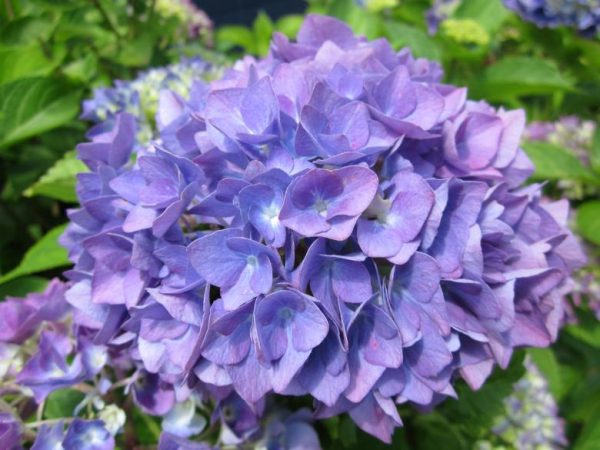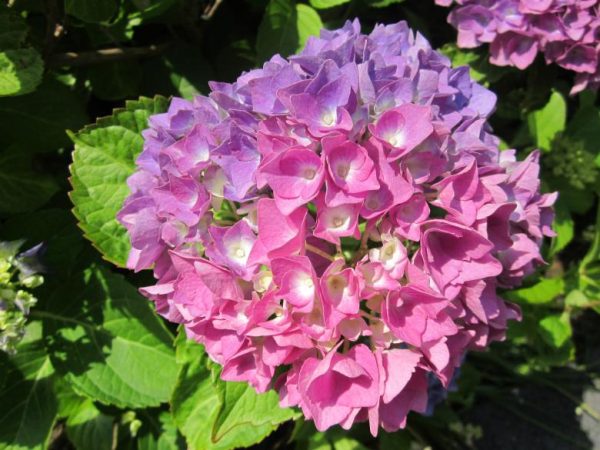How to acidify the soil for hydrangeas - proven methods
Hydrangea has a very amazing property - it is able to change color or its intensity depending on the acidity of the soil. What additives need to be added for this purpose? What should be done to achieve the maximum effect without harming the culture in this case?

How to acidify the soil for hydrangeas
What soil does hydrangea like
The flower prefers fertile clayey areas with slightly acidic or medium acidic soil. The most suitable acidity level for a plant is 5.5 pH. Land brought from the place of growth of conifers is ideal.
The following types of soil are absolutely unsuitable:
- sandy - due to a lack of micronutrients in it;
- heavy loamy - has the ability to retain moisture for a long time, has a tendency to waterlogging;
- alkaline.
It is desirable that in the first half of the day the sun's rays fall well on the beds, because the lack of lighting leads to a decrease in the abundance of flowering.
During the growth period, the beneficial nutrients that are part of the soil composition are gradually transferred to the plant. This is the reason for a decrease in the level of soil acidity. Acidifying the soil for the hydrangea will help remedy the situation.
Purpose of acidification
The acidity level affects the color of the buds:

Watering hydrangeas with citric acid proportion
- increased - gives the flowers of hydrangeas blue, purple, blue color shades;
- neutral - paints the petals white or beige, they become less bright;
- alkaline - makes them pink, lilac (large-leaved hydrangea (garden) has such a feature, and in paniculate and tree-like ones, only the color intensity can change).
Reference: hydrangea with greenish petals never changes its color.
The procedure is also needed for a number of other reasons:
- the plant assimilates additional fertilizing only through acidified soil, in fact, not perceiving them from neutral soil;
- with an acidity coefficient of 5.5 pH, the culture grows better;
- inflorescences are more lush, healthy, attractive in appearance.
The litmus test (sold in special stores) helps to find out the balance of the soil. You can also use a vinegar solution (9%). The soil is loosened and a small amount of the product is poured onto it. An alkaline soil will be indicated by the appearance of a characteristic foam.
The beds are acidified until the acidity coefficient is established in the range of 4.5 - 5.5. How long it may take depends on the soil: loose earth or black earth is acidified more easily, and on heavy and clayey the process is slower.
How and with what to acidify the soil
It is necessary to start the process of increasing the acidity of the soil in the spring. The signal for the beginning of the procedure should be the awakening of the culture after a state of rest. It is advisable to add acidifying agents in sunny weather.The introduction is carried out until the end of the growing season.

Feeding hydrangeas with citric acid
Loose soil is acidified most easily. It is enough to add organic substances to it. In this case, acidification occurs gradually, in the process of decomposition of organic compounds. It can be accelerated by adding humus from oak leaves, peat moss.
Important! The introduction of organic substances into clay, rough soil, on the contrary, reduces the coefficient of its acidity, turning it into alkaline.
There are several ways to acidify. They must be prepared and applied using a special technology.
| Product | Features of the | Cooking technology | Number of treatments |
| Lemon acid | One of the most harmless remedies. | 1 tsp for a bucket of water | Once every 30 days |
| Potassium permanganate | The most powerful oxidizing agent. In addition to coloring the petals in a beautiful blue color, the product promotes generous flowering, protects against fungal diseases. | The solution should be weak, have a pale pink color, all crystals should be completely dissolved, since a strong concentration of potassium permanganate can cause burns to the rhizome and petals. | Irrigation is carried out in the spring: 3 times with breaks from 14 to 21 days, the volume of raw materials is about 50 liters. |
| Vinegar 9% | Can be replaced with apple cider vinegar, oxalic acid. | 100 ml for 1 bucket of water This is enough for 1 sq. m. beds. | It is applied 2 times a month, starting from the stage of flower awakening, after dormancy, and until the end of the season. |
| Potassium alum | They help to paint the petals in blue-blue tones. A good effect is given by combination with iron-containing dressings. | Dilute 5 g per 1 liter of water. Pour 2 liters of solution under each bush. | Watering is carried out 2 times a month. |
| Copper sulfate 1% | A solution of copper sulfate will not only acidify the earth, but also disinfect it from fungal spores. | 5 g of salt per 10 liters of water. | Hydrangea is acidified in the spring, pouring the product under the bush 1 time in 3 to 4 weeks. |
| Dairy products | Top dressing is very useful due to the presence of lactobacilli in the composition - they enhance flowering and immunity. | 2 liters of whey or yogurt per bucket of water. First, the flower is watered with plain clean water, then the resulting product is poured under the bush. In addition to watering with the mixture, you can spray the foliage - this way the composition is absorbed faster. | It is allowed to add them every time the crop is watered. |
| Sulfur | Suitable for heavy clay soil. When interacting with bacteria, the agent turns into sulfuric acid. | 1 kg per 9 sq. m. | You need to feed the soil in advance, about 1 year before planting the plants. |
If, when using some organic products, additional irrigation of the bushes is allowed or even desirable, then when using chemicals for acidification, one should try to prevent their contact with the foliage of hydrangeas.
Information: the soil is acidified with ammonia fertilizers. But the introduction of calcium and potassium nitrates negatively affects the hydrangeas, since, on the contrary, they alkalinize the earth.
Precautions
In order to avoid causing harm to flowers, it is important to follow a number of rules during the breeding process:

Soil acidification for hydrangea
- choose a suitable place;
- provide nutritious soil;
- water regularly and in a timely manner, trying to do it closer to the roots, without touching the foliage and stems, making sure that moisture in the soil does not stagnate;
- maintain the permeability of the soil by introducing peat and sand into it for better moisture penetration to the root system;
- loosen the soil after each wetting;
- apply the required fertilizers on time and to the extent recommended;
- carry out pruning.
Recommendation: in order to avoid a lack of moisture, it is advisable not to plant hydrangea in close proximity to vegetation with a superficial root system.
What happens if you over-acidify the soil
Despite the flower's love for slightly acidic or medium acidic soil, you need to know when to stop in everything.As mentioned above, the ideal pH is 5.5.
At a pH value of 6.4, nutrient deficiencies begin. This can lead to plant disease. It is not recommended to over-oxidize the soil to a pH value in excess of the 7.0 reading. This is fraught with serious consequences, up to the death of culture.
How to fix the situation after watering
It is possible to again increase the amount of alkali and reduce the acidity of the soil after irrigation, which led to increased indicators, using preparations containing calcium carbonate:

How to acidify the soil for hydrangea
- dolomite flour, which also contains magnesium ions, which is very useful for hydrangeas;
- slaked lime;
- chalk, etc.
These foods help the soil to get rid of acidic aluminum salts.
By themselves, calcium-containing preparations do not have an alkaline reaction, but when they are combined with aluminum chloride, a soluble salt is obtained - calcium chloride, and aluminum precipitates, which leads to neutralization of the soil. This process does not happen quickly.
Note: the less grinding of limestone preparations, the better and faster they neutralize the soil.
The amount of material depends on the level of acidity of the soil and is approximately 200 g per 1 sq. m.
To achieve a faster effect of neutralizing acidic soils, you need to use oven ash. It contains alkaline potassium compounds.
Attention! Never use baking soda to neutralize soil.
Which is better: vinegar or citric acid
The effect of citric acid and vinegar is almost the same. Their introduction is not watering or top dressing as such, but only serves as a means for the formation of the required acidity coefficient of the soil pH.

How to acidify hydrangea soil with citric acid
Also, in both cases, there is a risk of negative impact on the soil microflora. However, citric acid is slightly milder. Its dosage rate is more difficult to exceed.
It is desirable to combine both products with organic and mineral fertilizing, other agricultural equipment.
By acidifying the soil on which hydrangeas grow, you can significantly improve the appearance of flowers, make them more lush, graceful, and provide a variety of color shades.


